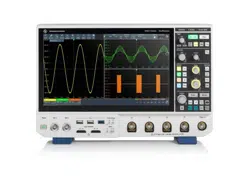Loading ...
Loading ...
Loading ...

Rohde & Schwarz R&S®MXO4 Series Oscilloscope 33
Trigger system
Trigger jitter
full-scale sine wave of frequency set to –3 dB
bandwidth
< 1 ps (RMS) (meas.)
Coupling mode standard same as selected channel
HF reject
cutoff frequency selectable from 100 kHz to 50 %
of analog bandwidth
LF reject attenuates < 50 kHz
Trigger hysteresis modes auto (standard) or manual
sensitivity
10
–4
div, from DC to instrument bandwidth for all
vertical scales
Holdoff range time 100 ns to 10 s, fixed and random
Main trigger modes
Edge triggers on specified slope (positive, negative or either) and level
Glitch
triggers on glitches of positive, negative or either polarity that are shorter or longer than specified
width
glitch width 200 ps to 1000 s
Width
triggers on positive or negative pulse of specified width; width can be shorter, longer, inside or
outside the interval
pulse width 200 ps to 1000 s
Runt
triggers on pulse of positive, negative or either polarity that crosses one threshold but fails to cross
a second threshold before crossing the first one again; runt pulse width can be arbitrary, shorter,
longer, inside or outside the interval
runt pulse width 200 ps to 1000 s
Window
triggers when signal enters or exits a specified voltage range; triggers also when signal stays inside
or outside the voltage range for a specified period of time
Timeout triggers when signal stays high, low or unchanged for a specified period of time
timeout 0 ps to 1000 s
Interval
triggers when time between two consecutive edges of same slope (positive or negative) is shorter,
longer, inside or outside a specified range
interval time 200 ps to 1000 s
Slew rate
triggers when the time required by a signal edge to toggle between user-defined upper and lower
voltage levels is shorter, longer, inside or outside the interval; edge slope may be positive, negative
or either
toggle time 0 ps to 1000 s
Setup & hold
triggers on setup time and hold time violations between clock and data present on any two input
channels; monitored time interval may be specified by the user in the range from –100 s to 100 s
around a clock edge and must be at least 200 ps wide
Pattern
triggers when a logical combination (and, nand, or, nor) of the input channels stays true for a period
of time shorter, longer, inside or outside a specified range
State
triggers when a logical combination (and, nand, or, nor) of the input channels stays true at a slope
(positive, negative or either) in one selected channel
Advanced trigger modes
Sequence trigger (A/B/R trigger)
triggers on B event after occurrence of A event; delay condition after A event specified either as time
interval or number of B events; an optional R event resets the trigger sequence to A
A event any trigger mode
B event
edge, glitch, width, runt, window, timeout,
interval, slew rate
R event
edge, glitch, width, runt, window, timeout,
interval, slew rate
Serial bus trigger optional see dedicated triggering and decoding options
Trigger input input impedance 50 Ω (meas.) or 1 MΩ (meas.) || 11 pF (meas.)
max. input voltage at 50 Ω 30 V (V
p
)
max. input voltage at 1 MΩ
300 V (RMS), 400 V (V
p
),
derates at 20 dB/decade to 5 V (RMS) above
250kHz
trigger level ±5 V
sensitivity
input frequency ≤ 500 MHz 300 mV (peak-to-peak) (meas.)
input coupling
AC, DC (50 Ω and 1 MΩ),
HF reject (attenuates > 50 kHz or
> 50 MHz, user-selectable),
LF reject (attenuates < 5 kHz or < 50 kHz,
user-selectable)
trigger modes edge (rise or fall)
Loading ...
Loading ...
Loading ...
